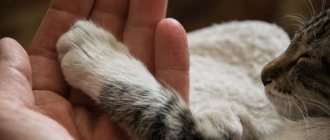Feline leukemia is one of the most dangerous incurable retroviral diseases of cats, which is dormant (hidden, sluggish) and does not manifest itself until the beginning of the terminal phase. Together with infectious peritonitis and immunodeficiency in cats, leukemia is included in the ominous list of “tri-fatal” infections, characterized by high contagiousness and lethality.
Other names for leukemia in cats are VLK, FeLV, blood cancer, leukemia, viral leukemia, Leucaemia viralis, lymphosarcoma, hemoblastosis.
Why is it dangerous to neglect treatment for leukemia?
Lack of treatment is fraught with the development of the disease and its accompanying pathologies, which lead to death. An animal that does not receive veterinary care develops:
- anemia;
- spontaneous bleeding;
- chronic cystitis;
- constant low-grade fever;
- bacterial infections;
- viral respiratory diseases;
- peritonitis;
- ascites;
- toxoplasmosis;
- autoimmune glomerulonephritis;
- stillbirth;
- damage to the mammary glands in females;
- miscarriages;
- fetal resorption and fading kitten syndrome;
- sarcoma of the lymphatic system.
A pregnant cat with leukemia will give birth to already infected kittens, which usually do not survive due to the body’s lack of strength to fight the virus. Therefore, cattery owners should definitely examine their cats.
How does it manifest?
Viral leukemia can be asymptomatic for months or even years. The disease can become active due to stress, decreased immunity, and other diseases. Symptoms are varied and nonspecific, depending on the subgroup of the virus. The most common are the following:
- frequent infections of the respiratory tract, nose, eyes, ears, skin, often difficult to treat
- viral infections in animals vaccinated against them
- lethargy
- gingivitis (inflammation of the gums)
- stomatitis (inflammation of the mouth)
- loss of appetite
- progressive weight loss
- abortions and stillbirths in cats
- enlarged lymph nodes
- frequent persistent diarrhea
- anemia (low red blood cell count)
- leukemia, often progressing to leukemia
- “fading kitten syndrome”: newborn kittens die within a few weeks
- lymphoma (benign tumor of lymphoid tissue)
- lymphosarcoma (malignant tumor of lymphoid tissue)
Which cats can get leukemia?
All cats are at risk. Stray animals, domestic animals, young and old, purebred and mixed-breed animals are susceptible to the disease.
Why, then, are they not all carriers of the virus? The fact is that the virus is quite unstable to external influences. In the external environment, it most often dies within a couple of days. It is dangerous from sunlight, ultraviolet rays, low and high temperatures. It is vulnerable to disinfectants and alcohol-containing products. Nevertheless, it is incorrect to even talk about the relative safety of animals.
Reference! Cats, due to their lifestyle, are more often susceptible to the disease (fights, including for the right to mate with a cat in heat).
Causes and conditions of occurrence
Leukemia in cats occurs under two conditions - infection with a virus and a weak immune system. The virus is contained in all secretions of a sick animal, but is unstable in the external environment. Outside the body, VLK can live no more than 2 days. In sunlight or dry weather, its lifespan is even shorter. Antiseptics, detergents and ultraviolet irradiation are effective in fighting the virus at home.
Infection of healthy cats occurs:
- through common household items;
- with bites and scratches in a fight;
- sexually;
- when sniffing the marks of other animals;
- during mutual licking;
- with bites of fleas and other blood-sucking parasites;
- in utero;
- iatrogenically (through veterinary manipulation);
- through the owner’s clothes if he has been in contact with a sick cat.
Methods of transmission of the virus
The virus is highly contagious - the ability of the infection to be transmitted from sick animals to healthy ones. It is transmitted from a sick animal to a healthy one under the following conditions:
- contact with the host’s saliva, urine, feces, or secretions from his nose or eyes;
- biting during a fight or play;
- through shared dishes, toys, beds;
- sexually;
- in utero from mother to kittens (as a rule, such babies do not survive);
- through flea bites;
- at an exhibition when using common things or being close to a sick colleague;
- after the owner visits the house where the leukemic cat lives, or a shelter, without changing clothes;
- in a clinic where instruments and tables are not thoroughly sanitized after each patient.
The greatest prevalence of hemoblastosis is observed in crowded cat prides, in so-called granny apartments, in shelters, as well as in basements where homeless individuals live.
Detailed lecture from a veterinarian about leukemia in cats:
Transmission routes
The leukemia virus can be transmitted in different ways. It has been established that in the hereditary material of cats there are more than 100 types of copies of endogenous (internal) viruses. In the course of numerous studies, scientists have discovered that under the influence of certain conditions, these viruses begin to be independently released in the body of animals, which ultimately causes the development of chronic leukemia.
However, this phenomenon occurs quite rarely. Basically, leukemia is provoked by exogenous (external) viruses that live in the external environment. This type of viral organism was identified back in 1964, during the same period it was found that leukemia in cats has a viral course and can affect all cats.
So how is this disease transmitted? The following transmission routes are distinguished:
- contact through biting and licking;
- Infection can occur through shared drinking and eating cups, as well as the female's milk. The virus can enter through a shared toilet;
- sexually;
- through the placenta in utero;
- through blood. Typically, infection occurs through untreated medical devices and blood transfusions;
- The leukemia virus can be carried by fleas.
Note! A pathogenic pathogen of viral pathology can maintain active viability in an open environment for 48 hours. It can be released along with saliva, nasal mucus, urine, feces, and milk.
This pathology often affects street cats. The most unfavorable areas, in which there is a high probability of infection, are considered to be those in which there are many homeless and stray animals.
Veterinarians say that leukemia only affects cats and cannot infect other animals. There is no scientific evidence that the pathogen can be transmitted to humans. However, laboratory studies have established that the virus is capable of developing in human cells.
What causes the development of leukemia and what is its danger
The causative agent of the disease is an RNA-containing oncogenic retrovirus, which invades blood cells and destroys their genetic code. The Latin name is Feline leukemia virus. It was identified by scientists in Glasgow in 1964. Scientists have established a connection between cases of cancer of the blood and lymphatic system in cats with the detection of strains of this virus in their blood.
The virus is dangerous due to its oncogenicity and changes in blood composition, reducing the resistance of the cat’s body, and provoking secondary diseases. It begins its activity in the tonsils and lymphatic tissues of the nasopharynx, gradually spreading to the lymph, circulatory system, and brain.
Immune deficiency increases unnoticed. When the process spreads to the bone marrow, it is too late to fight, since the affected bone marrow produces more and more replicas of the virus along with blood cells, and leukocytosis progresses. Death usually occurs from diseases associated with hemoblastosis.
What happens after infection?
After entering the cat’s body, the virus enters (directly or through the bloodstream) into the tonsils of the pharynx, where its primary replication (reproduction) occurs in macrophages and B-lymphocytes. Then the affected cells enter the bloodstream, where they spread throughout the body and infect lymphoid tissues. In approximately 20% of cats, an adequate immune response occurs at this stage, and the virus is completely eliminated from the body.
If this does not happen (reduced immunity, young or old age, stress), the virus attacks the bone marrow and cells of the immune system (neutrophils, lymphocytes, eosinophils). In this case, the animal, even if clinical symptoms disappear, remains a lifelong carrier of the virus.
With further development of the infection, the virus continues to multiply in the hematopoietic organs and lymphoid system, and also infects glandular epithelial cells throughout the body, including the salivary glands, intestines, esophagus, pancreas, mammary glands, etc.
Symptoms of leukemia in cats
The disease is insidious in that it does not appear immediately, but when the number of leukocytes in the blood exceeds acceptable limits. In this case, helping your pet is very difficult, if possible at all.
Therefore, it is necessary to show your furry puppy to the veterinarian twice a year so as not to miss the first symptoms of the disease.
VLK in cats manifests itself with the following symptoms:
- drowsiness;
- lack of interest in games;
- frequent rises in temperature;
- loss of appetite;
- lethargy;
- salivation;
- frequent colds, cystitis;
- digestive problems;
- enlarged lymph nodes;
- discharge from the eyes and nose;
- bulging eyes;
- pallor of mucous membranes.
The symptoms are nonspecific, and the owner will not be able to independently figure out what is bothering his pet. By self-medicating, you can waste time and ultimately lose your pet.
Symptoms of the disease
Leukemia always causes a sharp decrease in immunity in cats. An infected animal is susceptible to frequent illnesses that are severe and have complications that tend to recur.
The remaining symptoms are associated with secondary infection and depend on its type. The following violations are almost always observed:
- frequent rises in temperature;
- loss of interest in outdoor games;
- increased drowsiness;
- poor appetite and refusal to eat;
- frequent colds, gastrointestinal problems;
- very often drooling can be observed, since the virus localized in the salivary glands causes disruption of their functioning;
- swollen lymph nodes;
- pallor of the mucous membranes.
Life expectancy of a cat after infection
How long a cat can live after contracting viral leukemia depends on its immunity. Typically, it takes 3 to 10 years from infection to death. The incubation period ranges from four days to eight months.
Unfortunately, 90% of infected animals die in the 4th year of the disease. This high mortality rate is due to the fact that obvious symptoms appear 3 years after the cat is infected.
With good care, the animal remains a carrier of the infection for a long time, but does not get sick, and clinical signs of the virus do not appear. However, carrying the virus poses a danger to other cats.
Treatment
There are no drugs that kill the virus yet. Treatment of leukemia in cats consists of symptomatic care. However, with good care and properly selected therapy, you can maintain high immunity for a very long time, so that your pet will not even feel that he is sick.
For this purpose, immunostimulating drugs (Interferon, Azidotimidine, Raltegravir) are prescribed. High-quality, nutritious nutrition plays an important role. The best choice would be super premium and holistic food. This is the kind of food they use for their pets at the Murkosha shelter.
Read more about the right food: What food to feed your cat
Chemotherapy stops the development of the tumor and, in some cases, reduces its size. Such therapy is carried out with the drugs Cyclophosphamide, Vincristine, etc. Large tumors are removed surgically.
Blood transfusions and antianemic therapy provide good results in treating the disease.
Read about blood transfusions: Blood transfusions in cats
Can a person get infected from a cat?
Numerous studies prove that it is impossible to become infected with leukemia from cats . In the human body there is nothing for it to “catch onto”, since the DNA of a cat and a person do not have identical areas vulnerable to the virus. In addition, human leukemia has a completely different, non-viral nature.
Feline leukemia is not dangerous for dogs either.
Therefore, you should not be afraid to take such an animal into your home as your only pet or in the company of a carrier of the same virus.
Is there a danger to humans?
Detailed studies reliably confirm that infection of human leukemia from a cat is impossible. The virus cannot attach to human DNA, since the structure of this molecule is different in humans and cats. Virion will not be able to find fragments suitable for attachment. Leukemia in humans is of a non-viral nature. Dogs are not susceptible to VLK for a similar reason. Therefore, an infected cat does not pose a danger to people or dogs.
Types and forms of leukemia
An animal may have one or more retrovirus strains: A, B, C or T.
Depending on the state of immunity, leukemia in cats can occur in several forms:
- Transient (temporary). The initial period of the disease, until leukemia affects the bone marrow. At this stage, in rare cases, a strong immune system can develop a powerful response and destroy the pathogen completely. Such an animal receives lifelong immunity against viral leukemia. Typically, no more than two months pass from the onset of the disease, and these cats do not become a source of danger to others.
- Latent . This variety can occur when the immune system is strong. Replications of the virus are already present in the tissue structure, but the infection cannot multiply and become active. The animal remains a carrier, it may feel great, however, it poses a danger to healthy fellow tribesmen.
- A persistent or replication form of a viral organism. The weakened immune system no longer resists the penetration of the virus into the bone marrow structure. Signs of leukemia increase, primarily anemia. Particular harm is caused to the gastrointestinal tract, skin, bladder, and respiratory system.
Leukemia can be differentiated by type of localization:
- Thoracic leukemia is characterized by the accumulation of fluid in the chest area, due to which the animal becomes increasingly suffocated. Differential analysis with the wet form of viral peritonitis is required due to the similarity of symptoms;
- abdominal is characterized by damage to the gastrointestinal tract and resembles an intestinal disorder or jaundice; constipation, dehydration, and cachexia also develop;
- multifocal affects several organs at once and has a very poor prognosis due to the difficulty of diagnosis.
Definition of disease
In veterinary medicine, feline viral leukemia is usually called a disease characterized by a polysymptomatic course. It can manifest itself as immunodeficiency syndrome, the formation of malignant tumors, pathologies of various organs and systems, fetal death and miscarriages. Sick pets become more susceptible to other infections, which significantly distort the clinical picture of the disease and make diagnosis difficult.
Leukemia in cats occurs after the RNA-containing retrovirus FeLV enters the body and causes a significant decrease in immunity, provokes the development of malignant tumors in the spleen and red bone marrow. A very important factor is that the feline leukemia virus FeLV is not dangerous to humans and other animals, even with direct contact with the source of infection.
Note! This viral pathology should be distinguished from classic feline leukemia, which is an oncological disease with characteristic mutations in red bone marrow cells and the formation of cancer cells. Such leukemia most often develops under the influence of large doses of radiation, when carcinogenic substances enter the animal’s body, as well as hereditary genetic factors. In this case, the disease is not contagious to other cats and is manifested by a set of certain clinical signs.
The most susceptible to feline leukemia virus are kittens under 8 weeks of age born to unvaccinated mothers. Intrauterine infection is also possible. In both cases, the pathogen immediately enters the bloodstream, quickly spreads throughout all tissues of the body and provokes death.
The risk group also includes cats over 7 years of age and stray animals. A large percentage of sick young cats is explained by their activity during the period of sexual heat, when pets run away from home and come into contact with infected relatives.
Diagnostics
In order to confirm or exclude viral leukemia, and if confirmed, determine its type and form, the veterinarian performs a series of tests:
- clinical blood test - to determine the level of leukocytes in the blood, erythrocyte sedimentation rate, the presence of anemia;
- PCR - polymerase chain reaction - study of peripheral blood;
- immunofluorescence blood test , which allows you to detect antibodies to the virus and determine its type;
- ELISA is an enzyme-linked immunosorbent assay that detects the presence of antibodies and antigens to the virus in the blood.
Attention! If, while symptoms persist, all tests for VLK are negative, it is too early to calm down. It is necessary to retake them after three months and conduct a differentiated study, since the same symptoms may indicate completely different diseases.
Today, veterinary clinics are increasingly doing rapid tests for leukemia ; they provide a high degree of reliability, but it is better to play it safe and conduct a comprehensive analysis.
It also doesn’t hurt to conduct ultrasound and x-ray studies, which can help identify the presence of malignant neoplasms and see abnormalities in the functioning of internal organs.
In some cases, the following are recommended for diagnosis:
- biopsy;
- colonoscopy;
- gastroscopy;
- laparoscopy.
These are invasive or minimally invasive tests and are done under general or local anesthesia.
Types of leukemia
In addition to the above forms, viral leukemia in cats can be divided into types depending on the location. The main varieties include:
- leukemia of the thoracic region . During this form, fluid accumulates in the chest cavity, which gradually fills it. Next, it clogs the area of the trachea with the esophagus, which leads to the development of severe suffocation;
- abdominal lesion . The initial course of the pathological process is similar to a disorder of digestive functions. During it, appetite disappears, dehydration appears, and symptoms of jaundice and constipation occur. The pet becomes weak, he quickly loses weight;
- with multifocal leukemia, damage to several organs is noted at the same time. This type of disease, compared to the first two, is highly dangerous and cannot be completely cured. The most optimal and best result in this case will be to extend the life of the animal for a certain period.
Treatment of viral leukemia
It is not yet possible to completely cure a cat from leukemia. But timely symptomatic therapy will significantly alleviate the pet’s condition and prolong its life. The selection of drugs is carried out by a veterinarian strictly individually, depending on the condition, tests and symptoms of the patient.
Modern veterinary science suggests acting in two directions in cases of deteriorating health:
- Stimulation and strengthening of the animal's immunity . The following proven drugs are used:
- Raltegravir.
- Feliferon.
- Interferon.
- AZT.
Antibiotics and vitamin complexes are also used.
- Symptomatic therapy:
- with the help of medications, symptoms of diseases developing due to decreased immunity and inhibition of hematopoiesis are relieved;
- a good but temporary effect is achieved by blood transfusion , this procedure will have to be repeated every 2 weeks; if oncology is diagnosed, chemotherapy (in particular, Vincristine), usually in this way it is possible to stop the pathological process.
In addition, owners will have to reconsider their approach to feeding their pet. Food must be complete and of high quality, heat-treated to prevent germs, bacteria and other pathogens from entering the weakened body of a pet.
A cat diagnosed with viral leukemia will have to be kept in quarantine for life , contact with other cats must be prevented, and its bed, dishes, toys, and litter tray must be kept clean. If there are other cats in the house, then after contact with the carrier you need to thoroughly wash your hands and, if possible, change clothes. It is useful to regularly quartz the room in which the carrier cat lives (during quartzing, the animal must be removed from the room).
Important! Remember that euthanizing a cat is a last resort. Never give up in the fight against the disease, even without resorting to treatment.
Routes of infection
It is worth noting right away that only cats can become infected with leukemia. This virus is not dangerous for humans and other pets. Therefore, you can safely care for the animal.
A kitten can become infected with leukemia through saliva, blood, breast milk, urine and feces. Contacts with an infected animal during mating, fights, joint games, through a common bowl or tray will serve this purpose. Blood-sucking insects can also transmit the virus - from a sick cat to a healthy one.
Favorable conditions for the development of viral leukemia are present among unscrupulous scammers - “breeders” who only care about profit from the sale of kittens. There, sanitary rules of keeping are violated, there is a large overcrowding of animals - all this contributes to the spread of the virus. Therefore, if you are concerned about the health of cats, never deal with such scammers.
Read about how to recognize a divorcee: Beware, scammers! Razedentsy and bird markets
Prevention
You should not allow your pet to come into contact with stray and unexamined fellow pets, place it in dubious pet hotels and in unverified foster care, or use other people’s toys, trays, treats, food, bowls, beds, or medicines.
After the death of the previous cat from leukemia, it is recommended to get a new companion no earlier than 2 days after the death of the sick cat and only after cleaning the apartment. It is better to purchase new bowls and trays.
But the best way to protect your pet from viral leukemia is timely vaccination , which must be preceded by a carrier test. Kittens are vaccinated at the age of 2 months and repeat this procedure annually. The vaccine does not kill the infection, but increases the body's resistance to the virus and has a cumulative effect. Therefore, it is important not to forget to vaccinate your pet.
Viral leukemia is one of the most dangerous pathologies in cats. The prognosis for the disease is unfavorable, but still, in our time, lymphosarcoma is not a death sentence, so it is important to recognize VLK at the initial stages of development using comprehensive diagnostics. A timely visit to a specialist will help improve the quality of life of your furry cat and extend his days. To prevent infection, it is necessary to follow preventive measures and pay attention to the general condition of the animal.
Treatment of the disease
After a complete diagnosis and determination of the presence of leukemia in cats, a veterinarian must prescribe effective treatment.
Depending on the identified symptoms and forms of the disease, the treatment process can be aimed at eliminating the symptomatic manifestations of the disease. Therapy should also be prescribed to increase the animal's immunity.
To quickly prevent viral leukemia in cats, veterinary specialists prescribe a number of procedures and recommendations:
- To increase and strengthen the immune system, it is recommended to give your pet special medications with an immunostimulating effect. A list of medications is compiled by a veterinarian in accordance with the condition of the sick animal. The most suitable drugs with an immunostimulating effect are considered to be Interferon, Azidotimidine (AZT), Raltegravir;
- blood transfusion has a good effect;
- if anemia develops, drugs are prescribed to increase hemoglobin in the blood;
- If an animal develops cancer, chemotherapy is given. This procedure in most cases prevents the development of the pathological process.
Disease prevention
To prevent infection, the following rules must be followed:
- Avoid contact between your cat and street animals.
- Clean the floor with chlorine-containing substances several times a week.
- Wash your pet's bedding once every 3 months at high temperature.
- Prevent your pet from accidentally mating with other animals.
- Do not let the cat outside.
- Give your pet vitamins to maintain normal immune function.
- Avoid low-quality food.
- At the first symptoms of leukemia, consult a veterinarian and do not self-medicate.
Your cat's bedding should always be clean.
The best way to prevent infection is timely vaccination, which includes the use of drugs that can remain active throughout the year.
Risk group
The risk group for infection includes:
- elderly animals;
- cats after surgery who often go outside;
- pets mated with untested animals that may be carriers of the virus;
- cats infested with fleas and other blood-sucking insects;
- animals in the shelter.
Older cats are more likely to become infected
If a pregnant pet is sick with leukemia, the virus can easily be transmitted to kittens. Infection also occurs during feeding.
Testing before vaccination
Before administering the vaccine, the cat is tested for the presence of this virus. This procedure takes no more than 15 minutes. How testing is carried out:
- The doctor draws blood from the cat.
- Then he takes a separate test system and places 10 μl of the animal’s blood on it. This manipulation is carried out using an automatic pipette.
- After 15 minutes, the veterinarian evaluates the result. If testing confirms the presence of the virus, then vaccination is not carried out.
To determine leukemia before introducing serum, ELISA and PCR are also used, the results of which are often prepared within 24 hours.
Vaccination
Most often, vaccination is carried out using the drug Purevax FelV, which is a recombinant substance consisting of living and dead viral particles. Moreover, when a pathogen introduces itself into a pet’s body, the immune system quickly recognizes it and destroys it, which will protect the cat from a life-threatening illness. It is advisable to give the first vaccination to the animal at 8 weeks of birth, and the second at 12, and then repeat the vaccination annually.
Regular cat vaccination can protect against leukemia infection
The drug Purevax can protect your pet not only from leukemia, but also from panleukopenia, chlamydia and herpes virus.
What is feline leukemia virus
The feline leukemia virus is a retrovirus and has a widespread but uneven distribution. The virus attacks the cat's immune system, disrupting its function and making it susceptible to the development of secondary and opportunistic infections (those that a healthy immune system usually suppresses itself). In addition, the virus has an oncogenic effect, causing uncontrolled reproduction of cells affected by it with the development of lymphomas and leukemia.
It is the defeat of the immune system that provides a wide variety of clinical manifestations in viral leukemia. The signs of the disease are especially pronounced in the organs and systems that perform the barrier function - the digestive and respiratory systems, as well as the skin.
The feline leukemia virus is unstable in the external environment and is easily destroyed by disinfectants, treatment with soap solutions, as well as drying or heating.
Difference from immunodeficiency virus
Feline leukemia virus is often confused with feline immunodeficiency virus because they are both retroviruses that attack the immune system while exhibiting similar symptoms. But there are differences between these pathogens:
- The feline immunodeficiency virus affects only mature cells of the immune system circulating in the blood, while the feline leukemia virus affects the hematopoietic organ - the bone marrow, causing the production of pathologically altered cells of the immune system, which are unable to perform protective functions and themselves participate in the course of the disease, forming tumors . Thus, immune disorders in viral leukemia are much more complex and severe than in viral immunodeficiency.
- With feline viral leukemia, lymphomas often develop due to the activity of immune system cells modified by the virus, while with viral immunodeficiency there is a decrease or loss of functions of immunocompetent cells. Malignant neoplasms are not typical for him.
- The feline immunodeficiency virus has a wide variety of subspecies, which makes it difficult to create a vaccine. Nevertheless, a vaccine has been created, but is used only in the United States. To protect against viral leukemia, vaccine prophylaxis has been developed and is available everywhere.
- In veterinary medicine, cases of complete recovery from viral leukemia are known. No similar data have been reported on viral immunodeficiency disease.
In some cases, the similarity of the symptoms of these two diseases is so pronounced that it is possible to accurately determine the pathogen only using laboratory diagnostic methods.
The feline leukemia virus infects cells that tend to divide rapidly
Causes of the disease
The source of infection is cats with viremia - a condition when the virus circulates in their blood and is actively excreted through saliva, excrement, sputum, and also through milk during lactation.
In addition to domestic cats, large wild cats also suffer from viral leukemia. This pathogen is not dangerous for people, dogs, and other domestic animals.
Treatment of cats
Most often, the prognosis for the owner is disappointing. If the diagnosis is confirmed, it is recommended to euthanize the cat so that it is not a carrier of a dangerous virus and does not threaten the lives of other pets.
To ensure that this disease does not endanger the life of your pet, we strongly recommend that you come to the veterinary clinic for examinations more often and carry out the preventive measures recommended by doctors. This is the only way your cat will live long and make you happy every day!
It is important to understand!
To date, there is no effective treatment for infectious leukemia. For treatment, specialists prescribe therapeutic measures that will improve the patient’s condition slightly, but will still prolong his life.
Therapeutic treatment is aimed at supporting the sick animal and preventing secondary diseases. In treatment, specialists include: vitamins, antibiotics, anticancer drugs and other drugs that are prescribed individually for each person.
Preventive actions
This disease is considered incurable; its symptoms do not allow doctors to identify the disease at an early stage and this leads to massive damage to healthy animals. To prevent the disease, you need to carry out the following prevention:
- Vaccination is an effective method, but, unfortunately, not in all cases. It is more correct to conduct a test for the presence of antibodies to the pathogen before vaccinating a kitten.
- We recommend that you carry out the first vaccination from 12 weeks onwards annually with the vaccine against feline viral leukemia - Purevax FeLV
- Avoid contact with sick animals;
- Monitor the blood of pets when kept in groups;
- Disinfect the premises more often.
The leukemia virus does not exist in the environment for a long time; it is destroyed by exposure to even the weakest disinfectant. To completely destroy a dangerous pathogen, it is enough to regularly wet clean the house using soapy water and then your pets will be safe!
What symptoms indicate the disease
The leukemia virus is secretive for a long time. The following signs may indicate that your cat has FeLV:
- exhaustion, lethargy;
- fever, brick-brown urine;
- overexcitation or drowsiness;
- pallor, swelling of the mucous membranes;
- loss of movement coordination;
- skin pathologies (wounds, scabs around the claws).
A cat with FeLV symptoms has difficulty breathing, has difficulty clotting, and has cold limbs and skin. Fainting, convulsions, and disruption of the gastrointestinal tract are observed.
Upon examination, the veterinarian diagnoses a tumor, anemia, paralysis, nodules in the intestines, enlarged lymph nodes, fluid in the pleural and abdominal cavity, rhinitis, sinusitis, peritonitis, edema, etc.
The acute course of the leukemia virus occurs without enlargement of the spleen and lymph nodes, or it is insignificant. Chronicization of the process results in the proliferation of lymphoid tissue and metastasis. FeLV is a systemic pathology, manifested by a complex of symptoms.
Is it possible to prevent viral leukemia?
Immunoprophylaxis is an effective way to avoid FeLV. You can vaccinate a completely healthy cat without being a latent carrier of the virus. Kittens begin to be given Pitman Moore, Fort Dodge, Merial, Solvay and Purevax FeLV vaccines at 10-12 weeks.
If a cat is vaccinated before the birth of kittens, the babies become immune to FeLV up to 2-3 months of life. After this period, they are vaccinated against feline leukemia.
The spread of the virus can be prevented by observing sanitary and hygienic standards for keeping animals in groups. Promptly isolate and treat patients, disinfect the premises and utensils. Domestic animals should not be allowed to come into contact with wild animals, especially in endemic areas.
Pathogen
The causative agent of infectious leukemia is a retrovirus belonging to the oncovirus subfamily.
During research, two groups of feline oncovirus were identified: endogenous and exogenous. An endogenous virus is not pathogenic and cannot cause the development of an infectious process in the body; an exogenous virus is pathogenic and is the causative agent of infectious leukemia in domestic cats.
The low virulence of the pathogen and the high resistance of the cat explains the lack of development of the disease after contact with a sick animal or virus carrier.










